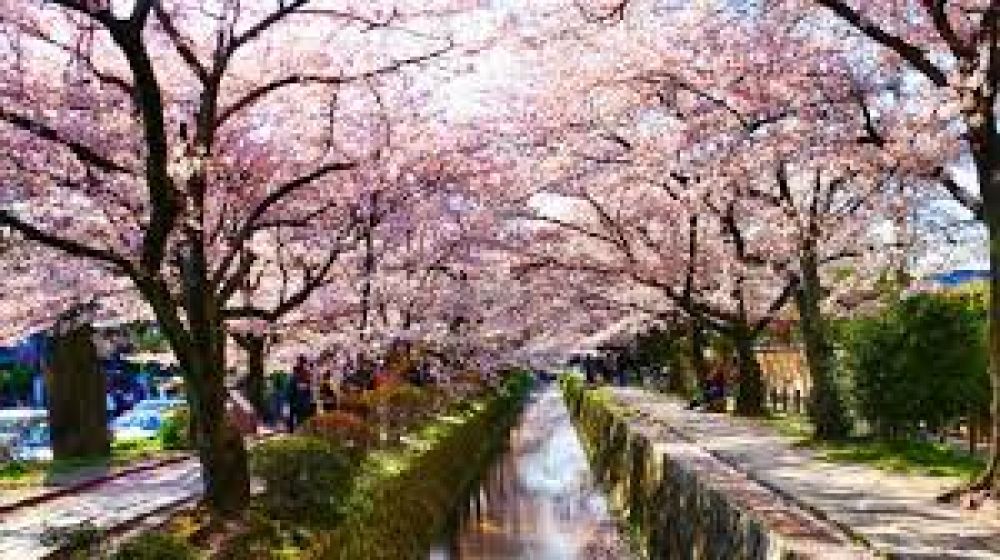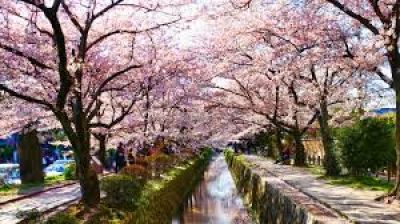

Philosopher's Path, known as Tetsugaku no michi in Japanese, is a scenic stone path that follows a cherry tree-lined canal in Kyoto, stretching from Ginkaku-ji (Silver Pavilion) to the neighborhood of Nanzen-ji. The path received its name due to the influence of one of Japan’s most famous philosophers, Nishida Kitaro, who was said to meditate while walking this route on his daily commute to Kyoto University. As you meander along this approximately two-kilometer stretch, you'll pass cafes, restaurants, boutiques, and a number of smaller temples and shrines that offer a serene atmosphere away from the bustling city. During spring, the cherry blossoms create a breathtaking tunnel of flowers over the canal, while autumn brings a vibrant display of fall colors. This contemplative walk allows visitors to experience the natural beauty and cultural significance of Kyoto, making for a memorable and peaceful outing.
Ginkaku-ji Temple, the Silver Pavilion, marks one end of the Philosopher's Path and is a must-visit cultural site in Kyoto. Although it is named the Silver Pavilion, the temple was never covered in silver; instead, it is famed for its beautiful architectural design and historical significance. Built in the late 15th century as a retirement villa for the Shogun Ashikaga Yoshimasa, it later became a Zen temple. Visitors can explore the meticulously landscaped gardens that feature carefully raked sand—symbolizing the ocean—and a variety of moss, as well as the iconic pavilion reflected in the tranquil pond. It offers a perfect example of the union between Japanese culture, architecture, and nature. Spending time in this serene environment provides insight into the aesthetic of wabi-sabi, highlighting the beauty in simplicity and the natural cycle of growth and decay.
While in Kyoto, engaging in a traditional Japanese tea ceremony is a unique cultural experience that can be enjoyed along the Philosopher's Path. Various tea houses in the area offer the chance to participate in this time-honored ritual. The ceremony, known as sado or chanoyu, is a choreographed art form focusing on the preparation and presentation of matcha, powdered green tea. During the tea ceremony, guests can learn about the philosophy of tea, which emphasizes respect, purity, tranquility, and harmony. The ceremony provides an in-depth look at Japanese culture and the art of tea, a key aspect of Kyoto's history. The ritual of preparing and drinking matcha in such a setting allows for a meditative and mindful experience, reflecting the path's philosophical heritage.
Located just a short walk from the Philosopher's Path, Eikan-do Zenrin-ji Temple is known for its stunning autumn foliage and its historical significance in the Pure Land sect of Japanese Buddhism. The temple grounds are expansive and include various halls, pagodas, and a beautiful pond garden. Visitors can explore the Tahoto Pagoda, which offers panoramic views of the surroundings, and admire the famous statue of Mikaeri Amida, a Buddha statue that is unique for looking over its shoulder. The temple is particularly active during the fall season when the maple trees turn brilliant shades of red and yellow, creating an enchanting atmosphere that attracts photographers and nature lovers. A visit to Eikan-do is a journey through the changing seasons of Kyoto and offers a deeper understanding of the city's spiritual and aesthetic values.
The Philosopher's Path is a wonderfully picturesque area that will delight any photography enthusiast. With its scenic canal bordered by cherry blossoms in spring or fiery maple leaves in autumn, the path offers countless opportunities for capturing the essence of Kyoto. Various landmarks, such as the Otoyo Shrine with its charming guardian mouse statues, or the small yet enchanting Anraku-ji Temple with its thatched gate, provide a rich tape?stry of subjects to photograph. Photographers can capture the daily lives of locals, the seasonal changes, and the tranquil beauty of the temples and shrubs along the path. Organized photography tours led by local experts are also available, offering guidance in finding the best spots and insight into the historical context of the sights.
Kyoto is famous for its traditional crafts, and pottery is among the most celebrated. Along the Philosopher's Path, visitors have the opportunity to attend workshops where they can learn the art of Kyo-yaki and Kiyomizu-yaki, the local styles of ceramics. These workshops often provide a comprehensive experience that includes an introduction to the history and techniques of Kyoto ceramics, followed by hands-on pottery making. Participants can create their own pieces, such as tea bowls, plates, or vases, under the guidance of experienced potters. It's a wonderful way to immerse oneself not only in the local culture but also to tap into the philosophy of wabi-sabi as you shape and decorate your unique ceramic artifact. At the end of the workshop, you will have a memorable keepsake to remind you of your time spent in Kyoto.
The Jizo-Uri, or 'Jizo-selling area', is a charming section near the Philosopher's Path where travelers can shop for traditional souvenirs, crafts, and local specialities. Jizo is a deity known for protecting children and travelers, and the numerous Jizo statues in the area reflect this benevolent presence. Shoppers can find handcrafted goods such as textiles, ceramics, and woodwork, each embodying the artisanal spirit of Kyoto. The nearby shops and stalls also offer a variety of snacks, including Kyoto’s famous sweet treats like yatsuhashi and matcha-based confections. This casual shopping experience is enhanced by the warm and welcoming nature of the local vendors, making it a delightful way to take a piece of Kyoto's unique culture and craftsmanship back home with you.
The Otoyo Shrine is one of the smaller shrines located along the Philosopher's Path, but it is renowned for its calm and peaceful environment. This Shinto shrine is dedicated to the rat deity, which is believed to be a messenger of the divine. Visitors seeking a quiet retreat from the city can find solace here amidst the lush greenery and traditional structures. While the shrine is a modest one, the tranquility it provides makes it a worthwhile stop for meditation and reflection. You can observe locals paying respects, enjoy the serene atmosphere, and perhaps be lucky enough to witness a traditional Shinto ceremony. This shrine offers a glimpse into the spiritual side of Japanese culture, marked by simplicity and connection with nature.
Kyoto is city that embraces its traditions and celebrates the changing seasons with various festivals (matsuri) throughout the year. When visiting the Philosopher's Path, inquire about any seasonal events happening during your stay. Spring often showcases the magnificent Hanami festivals, where locals and tourists alike gather to view the blossoming cherry trees. Lantern festivals in the summer light up the nights, and autumn matsuri celebrate the changing leaves with parades and cultural performances. These festivals provide an abundance of activities, including traditional games, food stalls offering local delicacies, and performances displaying Kyoto’s arts and crafts. Experiencing a Kyoto festival along the Philosopher's Path is an unforgettable opportunity to engage with the vibrant local culture and participate in its time-honored celebrations.
For food enthusiasts, there’s no better way to experience Kyoto’s renowned cuisine than to embark on a gastronomic tour near the Philosopher's Path. These tours introduce participants to a wide array of Japanese culinary delights from kaiseki, a traditional multi-course dinner, to simple pleasures like yakitori and okonomiyaki. Visitors can also sample sake at local breweries or enjoy matcha in a tea house setting. With guidance from a knowledgeable local guide, you'll visit various eateries and learn about the ingredients and techniques that define Kyoto’s food scene. This type of tour not only broadens your culinary horizons but also provides valuable insights into Japanese culture through its cuisine. The experience will deepen your appreciation for Kyoto as a city of both cultural and gastronomic richness.
